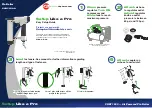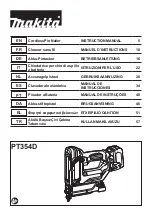
15
Interchange Brands Framing Nailers: Operator’s Manual
MAINTENANCE AND INSPECTION
INSPECCION Y MANTENIMIENTO
MAINTENANCE ET INSPECTION
Disconnect air hose.
Clean the magazine. Remove dust and other debris
that may have accumulated in the magazine.
Lubricate the nail rail with tool oil.
Check that the nail feeder slides smoothly by pulling
it with your finger. If it does not slide smoothly, nails
can be driven at an irregular angle and injury may
occur.
In case of frequent jams, contact an authorized
service center.
A QUALIFIED PERSON SHOULD PERFORM
REPAIRS AND MAINTENANCE.
Desconectar la mangera de aire
Limpie el dispositivo. Quite el polvo y otros
residuos que pudiera haberse acumulado en el
dispositivo.
Lubricar el riel de la clavadora con aceite de
herramienta.
Verifique que el alimentador de clavos se deslice
suavemente cuando lo jale con el dedo, si no
se desliza suavemente los clavos pueden ser
conducidas a un ángulo irregular y producir un
accidente.
En caso de obstrucciones frecuentes, contacte
un centro de servicio autorizado.
UNA PERSONA CALIFICADA PUEDE
REALIZAR REPARACIONES Y
MANTENIMIENTO.
Débranchez le boyau d’alimentation d’air.
Nettoyez le magasin, enlevez la poussière ou
autres débris pouvant s’être accumulés dans le
magasin.
Lubrifiez le rail des clous avec un lubrifiant pour
outil.
Vérifiez que le poussoir de clous glisse librement
en le tirant avec votre doigt. S’il ne glisse pas
librement, les clous pourraient être enfoncés
avec un angle irrégulier et pourraient entraîner
des blessures.
Dans le cas de blocage fréquent, contactez un
centre de service autorisé.
UNE PERSONNE QUALIFIÉE DEVRAIT FAIRE
LA RÉPARATION ET L’ENTRETIEN.
UTILIZANDO LA CLAVADORA
(Opciones para todos los modelos)
UTILISATION DE LA CLOUEUSE
(Options pour tous les modèles d’outils)
COLD WEATHER CARE
CUIDADOS PARA CLIMAS FRÍOS
ENTRETIEN PAR TEMPS FROID
Do not store the tool in a cold weather environment.
Keep the tool in a warm area until beginning the
work.
If the tool is already cold, bring it in a warm area and
allow the tool to warm up before use.
1. Reduce the air pressure to 60 to 80 psi
(4.2 bar 4.2 kgf/cm2).
2. Remove all fasteners from the tool.
3. Connect the air hose and free-fire (blank-fire) the tool.
The lowered air pressure will be enough to free-fire
the tool.
Slow speed operation tends to warm up the moving
part.
No guarde el la herramienta en lugares fríos.
Déjelo en un lugar cálido antes de comenzar a
trabajar.
Si el la herramienta está frío, póngalo en un
lugar cálido y deje que se caliente antes de
utilizarlo.
1. Reduzca la presión de aire a 60 a 80 psi (4,2
barias 4,2 kgf/cm2).
2. Quite todos los sujetadores del la herramienta.
3. Conecte la manguera de aire y dispare (disparo
en vacío) el la herramienta.
La reducción de la presión de aire será suficiente
para disparar en vacío el la herramienta.
La operación a baja velocidad tiende a calentar
las partes móviles.
Ne pas ranger le l’outil dans un environnement
froid. Le laisser dans un endroit chaud jusqu’à ce
que l’on soit prêt à travailler.
Si le l’outil est déjà froid, l’amener dans un
endroit chaud et le laisser réchauffer avant de
l’utiliser.
1. Réduire la pression d’air à 60 à 80 psi (4,2 bars
4,2 kgf/cm2).
2. Sortir tous les fixations du l’outil.
3. Raccorder le tuyau d’air et faire un essai de
clouage (clouage à blanc).
La pression d’air inférieure sera suffisante pour le
clouage à blanc.
Les opérations à vitesse lente ont tendance à
chauffer les pièces mobiles














































